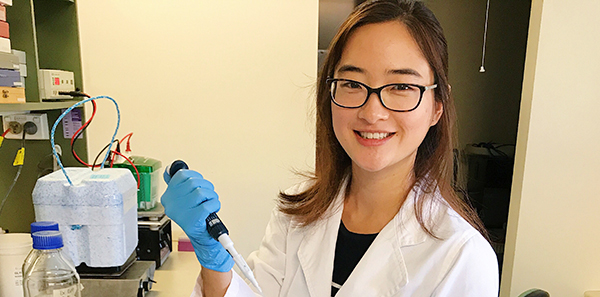1:30min

Daisy Shu
______________________________
By Helen Carter
Journalist
Talented young optometrist Daisy Shu has won a travel fellowship to a major US optometry conference for her promising research on blocking cataract formation.
She will present her research findings on the world stage when she attends the American Academy of Optometry 2017 annual meeting in Chicago on 11-14 October.
The academy selected her scientific presentation as one of the 10 most newsworthy items for the meeting and invited her to present a summary of her poster at an academy press conference. Her poster is titled ‘Inhibition of EGFR signalling is a novel approach to prevention of posterior capsular opacification.’
‘I am so excited to be presenting at the press conference and feel honoured to have been chosen for the fellowship,’ Ms Shu said.
She will receive a $750 American Academy of Optometry student travel fellowship, funded by an education grant from Johnson and Johnson Vision, at a student and residents award lunch on 12 October.
During the week Ms Shu works at the University of New South Wales in the School of Optometry and Vision Science as a tutor in ocular therapeutics and clinical supervisor of final-year students. On weekends she works in private practice.
Blocking cataract formation
She is undertaking a PhD at the University of Sydney, looking at the formation of cataract and posterior capsular opacification, and is being supervised by Professor Frank Lovicu and Professor John McAvoy who are pioneers in crystalline lens research.
They discovered a protein, transforming growth factor-beta, which could induce the formation of cataract in rat lens epithelial cells. They have established this as an animal model to study the mechanisms underlying cataract formation and plan to translate this to human tissue.
‘I had frequently encountered patients with cataract and I was always intrigued by the mechanisms underlying the various types of cataract from posterior subcapsular cataract to nuclear sclerosis,’ Ms Shu said.
‘My thesis delves into understanding the pathogenesis of cataract by understanding the growth-factor-signalling pathways underlying normal and aberrant lens cell behaviour. After surgery some people develop secondary cataracts on the implant called posterior capsular opacification and require further surgery to remove them,’ she told Australian Optometry.
‘I am studying the mechanics of why some lens epithelial cells undergo aberrant changes which turn them into cataract cells. By adding transforming growth factor-beta to normal rat lenses, I can induce cataract-like changes in the normal cells.
‘We know that transforming growth factor-beta is able to activate various signalling pathways and by adding inhibitors to block specific individual pathways, I can unravel the mechanisms underlying the pathogenic activity of transforming growth factor-beta.
‘When I inhibited the epidermal growth factor receptor (EGFR)-signalling pathway, I found that this could block the ability of transforming growth factor-beta to cause cataract. I’m now trying to understand how important EGFR-signalling is in cataract formation,’ she said.
Ms Shu also found that adding different growth factors, such as BMP-7, can also block cataract.
She has presented on this work at conferences and has had some findings published.
READ
Daisy Shu’s abstract on EGFR signalling, presented as a poster at ARVO this year
Her paper on the role of BMP-7 in blocking cataract
A review on the role of TGF-beta in wound healing in the eye
Her story about what inspired her to undertake research